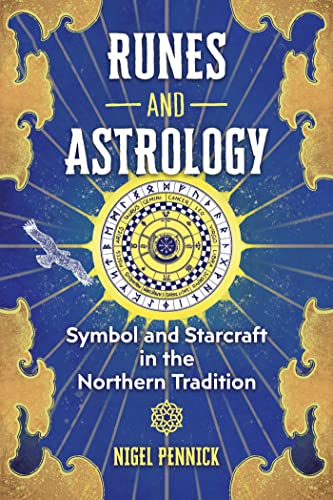Runes and Astrology is the 3rd edition of Runic Astrology (previously published in 1990). This book doesn’t fit neatly into a specific interest category because it contains such a polyglot of information. It includes a detailed assessment of esoteric concepts in Northern Tradition, truly excellent material about ancient time-keeping, time tracking methods and tools, and calendars before the modern age, and an updated discussion of the origin of runes. There is a myriad of methods for integrating runes into existing schemas like planetary hours, planetary day rulers, the Platonic Year, and a runic-overlay to the calendrical year that hinges on the eight sabbats or fire festivals. A potential method for creating a runic horoscope is presented as well. Pennick injects runes into as many time systems and astrological conventions as possible.
Some of this book’s contents are valuable simply because they can’t be found elsewhere. For instance, the discussion of Nordic cosmogony, orlog, wyrd and the Norns—i.e., how the cosmos was formed and Northern ideas about fate and destiny—is an excellent counter-point to the Greco-Roman concepts generally connected to Western esoteric tradition.
There’s a meat-and-potatoes overview of the runes in Chapter 2 “The Runes and Their Meanings.” The author outlines the organization of the 24 Elder Futhark runes into three groups called aettir. Each aett (group of eight) is sacred to a particular Norse deity. Each rune is described in depth with linguistic ties, ancient rune poems, corresponding herb, tree, elements, and deity association. The Anglo-Saxon stave names are used along with the reconstructed Germanic names to relieve confusion. The additional nine runes of the Younger Futhark, with Frisian, Anglo-Saxon, and Northumbrian origins, are described from page 61. Since these are less commonly used or discussed, this section offers valuable insights.
In Chapter 3 “Cycles of Space and Time”, Pennick approaches his main thesis about the runes and time-keeping. Runes are disbursed through the 24-hour day (corresponding to planetary hours) and around the wheel of the year. A number of curious numeric and arithmetic features of time-keeping are presented. Investigations into four- and eight-fold divisions shift to triadic structures, and then to 12/13 structures with King Arthur’s Round Table as an example. Chapter 4 “Solar Runepower” digs more deeply into the links between the runes and time. As Pennick states, “The observance of sacred times, which exists to bring us into harmony with nature, is at odds with modern commercial timekeeping.” (pg 114)
Chapter 5 “The Eightfold Way – The Year Cycle” shifts from the flow of daily time to the flow of seasonal time. A graph given on pgs 130-133 outlines each rune with its fortnight, significant days (saint’s days and Northern Tradition days) and emblems for the period. This list holds lots of treasures! An old system of runestock numeric notations is provided. There’s a detailed discussion of the origin and messy implementation of the modern Gregorian calendar during the 16th-17th centuries. It’s one of the best and most complete descriptions of this monumental global calendrical shift I’ve ever read.
A further section discusses possibilities for creating a personal name based on birth date and time, as well as choosing a baby name in a similarly auspicious manner. A useful chart with alternative forms of the rune names is given on pgs 149-150.
Chapters 6, 7, and 8 develop the runic overlay onto features of astrology. The Greco-Roman planetary deities are equated with Northern deities. The Younger Futhark’s 28 runes are applied to the lunar mansions along with Northern Tradition star/asterism names for the mansions (chart on pg 172). Runic relationships with the 25,920-year “Great Year” (aka Platonic Year) are considered. There are ancient Northern names, insofar as they have survived, for constellations and stars. Pennick discusses of the Fifteen (Behenian) Stars used in astrological magic. Providing the current longitudinal positions of these stars would have been helpful to readers less familiar with fixed stars. The final chapter offers ideas for casting a “runic horoscope.” The content in these final chapters is of questionable value, considering the original text was published over thirty years ago and that idea hasn’t caught on yet. The book ends with a postscript, eight appendices recapping graphs from different chapters for easy look-up, a glossary, bibliography, and index.
It’s difficult to assess the target audience for Runes and Astrology. Astrologers will find quite a few of the entries and historical overviews highly useful. People involved in Northern Tradition spirit work will find the annual time-keeping and naming ideas attractive. Rune readers will discover much useful material in the first few chapters and descriptions of rune meanings, but divination methods are absent. It’s a lengthy and detailed text with a great deal of valuable information that’s rarely found in any kind of book in the esoteric genre. Eccentric polymaths will revel in this book if they’re not thrown off by the title. This is a book that cannot be judged by its cover! There’s far more to it than meets the eye.
Author: Nigel Pennick
Destiny Books, 2023
290 pgs. $19.99 pb, $15.99 Kindle.
previously published as: Runic Astrology: Starcraft and Timekeeping in the Northern Tradition, 1990, Aquarian Press, UK

